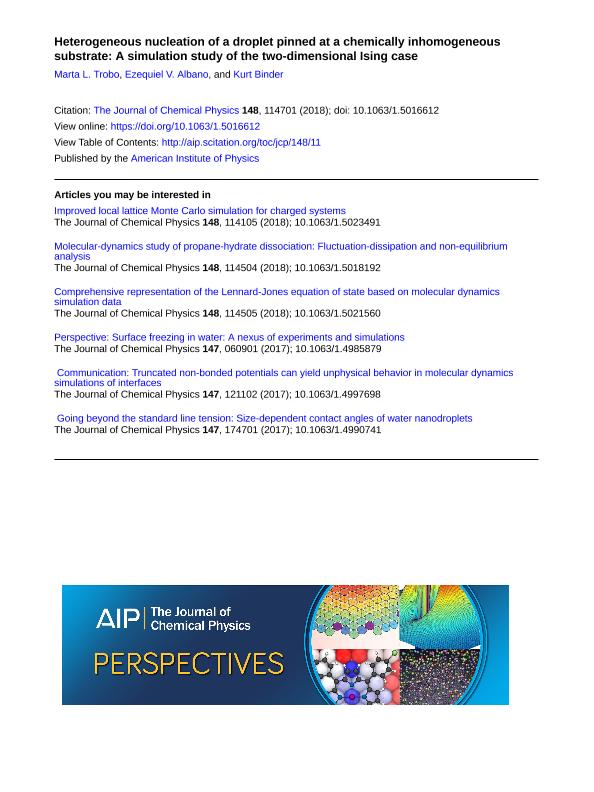Mostrar el registro sencillo del ítem
dc.contributor.author
Trobo, Marta Liliana

dc.contributor.author
Albano, Ezequiel Vicente

dc.contributor.author
Binder, Kurt
dc.date.available
2019-11-20T12:50:55Z
dc.date.issued
2018-03
dc.identifier.citation
Trobo, Marta Liliana; Albano, Ezequiel Vicente; Binder, Kurt; Heterogeneous nucleation of a droplet pinned at a chemically inhomogeneous substrate: A simulation study of the two-dimensional Ising case; American Institute of Physics; Journal of Chemical Physics; 148; 11; 3-2018
dc.identifier.issn
0021-9606
dc.identifier.uri
http://hdl.handle.net/11336/89250
dc.description.abstract
Heterogeneous nucleation is studied by Monte Carlo simulations and phenomenological theory, using the two-dimensional lattice gas model with suitable boundary fields. A chemical inhomogeneity of length b at one boundary favors the liquid phase, while elsewhere the vapor is favored. Switchingon the bulk field Hb favoring the liquid, nucleation and growth of the liquid phase starting from the region of the chemical inhomogeneity are analyzed. Three regimes occur: for small fields, Hb < Hcritb , the critical droplet radius is so large that a critical droplet having the contact angle required by Young?s equation in the region of the chemical inhomogeneity does not yet ?fit? theresince the baseline length of the circle-cut sphere droplet would exceed b. For Hcritb < Hb < Hb , such droplets fit inside the inhomogeneity and are indeed found in simulations with large enough observation times, but these droplets remain pinned to the chemical inhomogeneity when their baseline has grown to the length b. Assuming that these pinned droplets have a circle cut shape andeffective contact angles eff in the regime c < eff < /2, the density excess due to these dropletscan be predicted and is found to be in reasonable agreement with the simulation results. On generalgrounds, one can predict that the effective contact angle eff and the excess density of the droplets, scaled by b, are functions of the product bHb but do not depend on both variables separately. Since the free energy barrier for the ?depinning? of the droplet (i.e., growth of eff to c) vanishes when eff approaches /2, in practice only angles eff up to about maxeff ´ 70 were observed. For larger fields (Hb > Hb ), the droplets nucleated at the chemical inhomogeneity grow to the full system size. While the relaxation time for the growth scales as G / H1b , the nucleation time N scales as ln N / H1b . However, the prefactor in the latter relation, as evaluated for our simulations results, is not in accord with an extension of the Volmer-Turnbull theory to two-dimensions, when the theoretical contact angle c is used.
dc.format
application/pdf
dc.language.iso
eng
dc.publisher
American Institute of Physics

dc.rights
info:eu-repo/semantics/openAccess
dc.rights.uri
https://creativecommons.org/licenses/by-nc-sa/2.5/ar/
dc.subject
NUCLEATION
dc.subject
DROPLET
dc.subject
PINNED
dc.subject.classification
Física de los Materiales Condensados

dc.subject.classification
Ciencias Físicas

dc.subject.classification
CIENCIAS NATURALES Y EXACTAS

dc.title
Heterogeneous nucleation of a droplet pinned at a chemically inhomogeneous substrate: A simulation study of the two-dimensional Ising case
dc.type
info:eu-repo/semantics/article
dc.type
info:ar-repo/semantics/artículo
dc.type
info:eu-repo/semantics/publishedVersion
dc.date.updated
2019-10-17T20:14:13Z
dc.journal.volume
148
dc.journal.number
11
dc.journal.pais
Estados Unidos

dc.journal.ciudad
New York
dc.description.fil
Fil: Trobo, Marta Liliana. Universidad Nacional de la Plata. Facultad de Ingeniería. Departamento de Fisicomatemática; Argentina. Consejo Nacional de Investigaciones Científicas y Técnicas. Centro Científico Tecnológico Conicet - La Plata. Instituto de Física de Líquidos y Sistemas Biológicos. Universidad Nacional de La Plata. Facultad de Ciencias Exactas. Instituto de Física de Líquidos y Sistemas Biológicos; Argentina
dc.description.fil
Fil: Albano, Ezequiel Vicente. Consejo Nacional de Investigaciones Científicas y Técnicas. Centro Científico Tecnológico Conicet - La Plata. Instituto de Física de Líquidos y Sistemas Biológicos. Universidad Nacional de La Plata. Facultad de Ciencias Exactas. Instituto de Física de Líquidos y Sistemas Biológicos; Argentina. Universidad Nacional de La Plata. Facultad de Ciencias Exactas. Departamento de Física; Argentina
dc.description.fil
Fil: Binder, Kurt. Johannes Gutenberg Universitat Mainz; Alemania
dc.journal.title
Journal of Chemical Physics

dc.relation.alternativeid
info:eu-repo/semantics/altIdentifier/url/http://aip.scitation.org/doi/10.1063/1.5016612
dc.relation.alternativeid
info:eu-repo/semantics/altIdentifier/doi/http://dx.doi.org/10.1063/1.5016612
Archivos asociados
